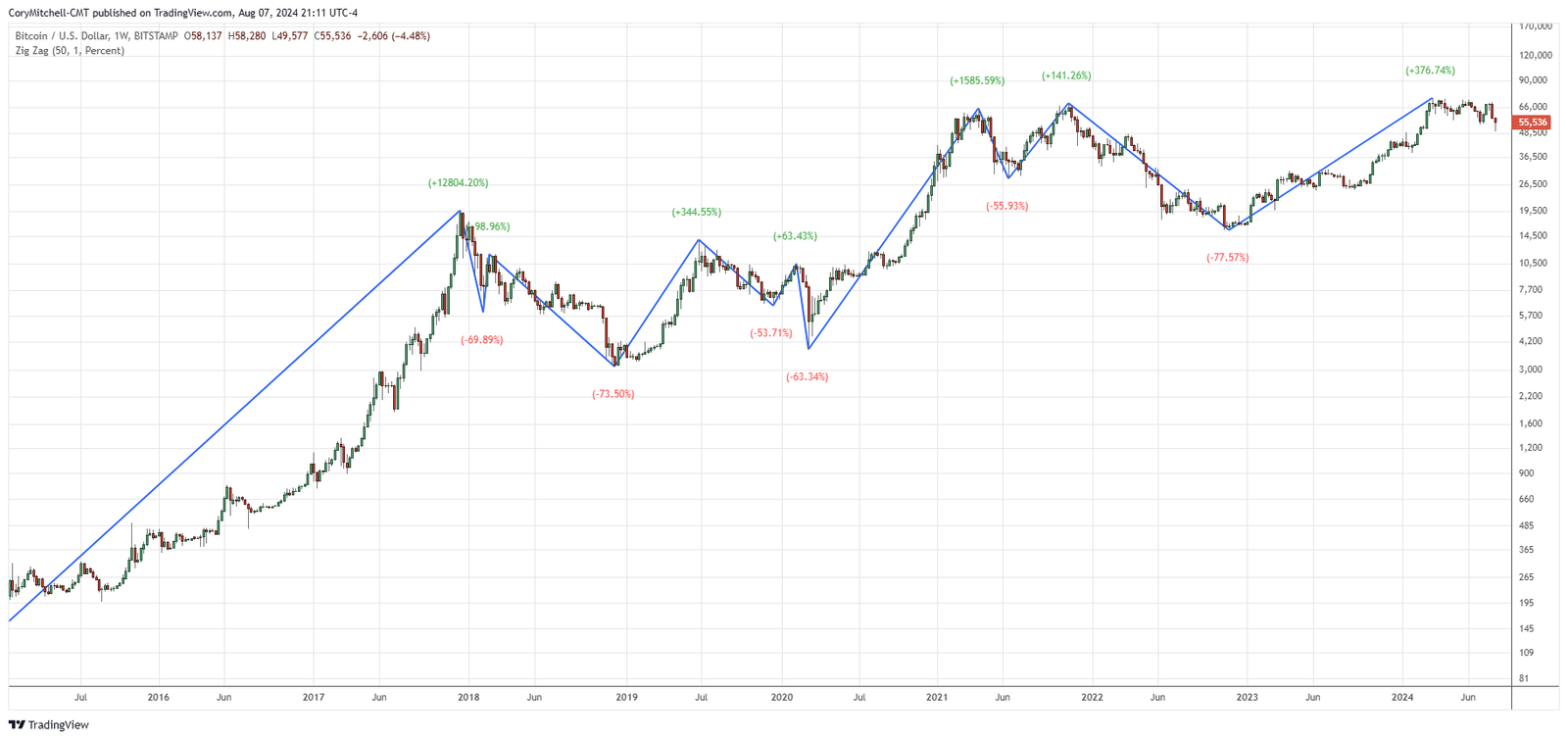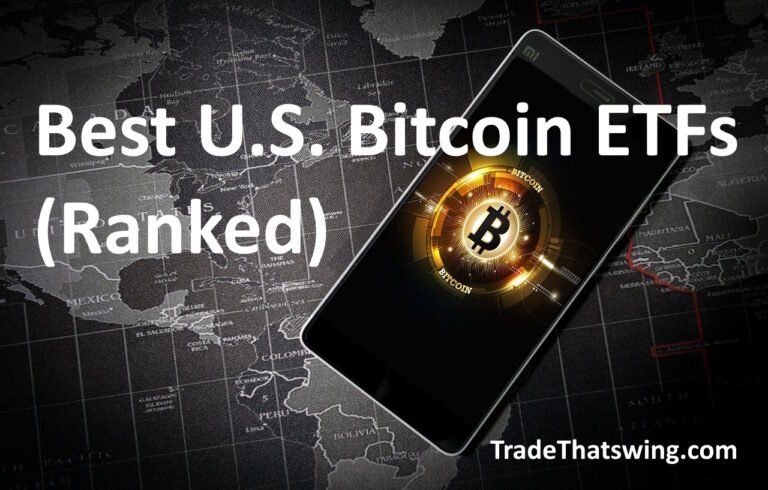Bitcoin ETFs provide a way to invest in the largest cryptocurrency in the world without a crypto account or using a crypto exchange, and the ETFs can be purchased through a U.S. tax-advantaged accounts such as a IRA or Roth IRA. This allows you to either not pay taxes on your Bitcoin profits (Roth IRA) or defer the taxes you pay on any gains until you start withdrawing (IRA).
What Bitcoin Is, Its Returns and Risk
Bitcoin is the largest cryptocurrency in the world in terms of market capitalization, according to Coinmarketcap. Market capitalization is the price of the coin multiplied by the number of coins in circulation.
Bitcoin, unlike many other cryptocurrencies, Bitcoin has a finite supply. Only 21 million Bitcoins can be created. As of August 2024, there are 19.7 million in circulation.
Bitcoin is like a currency in that it can be used to buy goods or services (assuming the provider accepts Bitcoin as payment). The Bitcoin is sent to the user’s digital address. Transactions, anywhere in the world, can typically be completed within minutes.
Bitcoin is a preferred choice of many investors for a few reasons:
- It’s the largest in terms of market cap.
- It has a limited supply. If demand stays strong and supply is limited that may help fuel prices higher over the long run.
- It is the original cryptocurrency. It launched in 2009 and has stood the test of time…so far.
But investing in Bitcoin may not be everyone. It is volatile. Very volatile. That can mean both big gains and big drops in price.
Since 2015, this chart shows the rally and drop percentages that are over 50%.
There have been six drops of at least 50% (following at least a 50% rally). On average, there is a 50% drop every 1-2 years. If you want a full breakdown of how Bitcoin moves, including how much it typically rallies and pulls back, and other statistics, see Statistics on How Bitcoin Moves.

But there are also big rallies: 12800,%, 99%, 345%, 63%, 1586% and 141% before another 50% or greater drop occurs. As of August 7, the latest rally is 377% following the last big decline (78%)
If you like big movement, you may also be interested in the Best Performing Stocks & ETFs.
Now that you know a little about Bitcoin, and how it can move, let’s look at some of the best U.S. Bitcoin ETFs.
Best U.S. Bitcoin ETFs in 2024
Each of these U.S. ETFs owns bitcoins. The price of the ETF, multiplied by the units of the ETF that are available, reflects the value of the bitcoin held. When you buy the ETF, you are buying fractional ownership of those bitcoins.
Since each ETF is tracking Bitcoin, most should move in a similar fashion. Yet each charges a different yearly fee, called an expense ratio.
A higher expense ratio will result in lower returns for you, the investor, because more of the returns are taken by the ETF managers.
Therefore, the best Bitcoin ETF in the U.S. is the one with the lowest fees.
All the ETFs on the list use “cold storage” for holding their bitcoins. Cold storage means the bitcoins are not accessible (to hackers) online. Hot storage, or a hot wallet, is when bitcoins are held in an account online. Having a wallet is not required for owning Bitcoin ETFs, since the fund is using its own.
Note that since many of the U.S. Bitcoin ETFs are newer, some have temporarily agreed to waive some of the management fees associated with the fund. This is a temporary measure. To create this list we have looked at what fees will be after the fees are implemented (since that will be very shortly for most ETFs).
Here are the top Bitcoin ETFs in the U.S. with ticker symbols, ranked in order from best to worst based on a combination of fees and returns. Additional details are in the charts below.
- Franklin Bitcoin ETF (EZBC)
- Bitwise Bitcoin ETF (BITB)
- VanEck Bitcoin Trust ETF (HODL)
- ARK21Shares Bitcoin ETF (ARKB)
- iShares Bitcoin Trust (IBIT)
Returns as of August 7, 2024.
Top Choice: Franklin Bitcoin ETF (EZBC)
| Inception Year: | 2024 |
| Expense Ratio | 0.19% |
| 3-Month Return | -13.81% |
| 6-Month Return | +26.87% |
| Assets Under Management: | $388 million |
| Daily Average Volume: | 0.3 million |
Updated stats on the ETF can be found on the Franklin Templeton information page.
All yearly returns were pulled from TradingView, so I could compare the exact same dates for each ETF. Other statistics are from the ETF’s website or documents.
This was picked as the best U.S. Bitcoin ETF because it has the lowest expense ratio. Generally that translates into better investment performance since more money stays in the investor’s pocket.
One downside is that the daily volume isn’t that high. More than enough for an investor to buy some, but not enough for an active day trader.
2nd Choice: Bitwise Bitcoin ETF (BITB)
| Inception Year: | 2024 |
| Expense Ratio: | 0.2% |
| 3-Month Return | -13.99% |
| 6-Month Return | +26.73% |
| Assets Under Management: | $2.1 billion |
| Daily Average Volume: | 2.3 million |
This Bitwise Bitcoin ETF was ranked second because it has the second lowest (non-promotional) expense ratio.
It is also one of the larger funds on the list in terms of assets under management and has higher daily average volume than some of the other top-ranked funds.
3rd Choice: VanEck Bitcoin Trust ETF (HODL)
| Inception Year: | 2024 |
| Expense Ratio: | 0.2% |
| 3-Month Return | -13.88% |
| 6-Month Return | +26.83% |
| Assets Under Management: | $597 million |
| Daily Average Volume: | 0.3 million |
You can stay updated on current statistics for the ETF on the VanEck Bitcoin Trust information page.
This fund also has lower volume, but a lower expense ratio than most other funds except EZBC.
Remember that on the surface some ETFs look free at the moment, but that is a promotion. Following the promotional period, most U.S. Bitcoin ETFs will have a higher fee than EZBC, BITB, and HODL.
4th Choice: ARK21Shares Bitcoin ETF (ARKB)
| Inception Year: | 2024 |
| Expense Ratio: | 0.21% |
| 3-Month Return | -13.95% |
| 6-Month Return | +26.57% |
| Assets Under Management: | $2.7 billion |
| Daily Average Volume: | 1.9 million |
The fee is just starting to creep up marginally on the ARK21 Bitcoin ETF, which is why it was ranked fourth. It has decent volume and billions under management.
These funds have only been around for a little more than six months, but ARK21 is just slightly underperforming the aforementioned funds. This can happen because ETFs don’t always trade exactly at their Net Asset Value (NAV)—what the assets in the fund are worth.
5th Choice: iShares Bitcoin Trust (IBIT)
| Inception Year: | 2024 |
| Expense Ratio: | 0.25% |
| 3-Month Return | -13.89% |
| 6-Month Return | +26.44% |
| Assets Under Management: | $18.9 billion |
| Daily Average Volume: | 28.4 million |
The iShares Bitcoin Trust is one of the most actively traded Bitcoin ETFs in the US. It has the highest daily average volume and assets under management of the funds on the list. Good for short-term trades, but longer-term investors will be paying a higher fee for no reason. Hence its fifth-place rank.
Once its promotional period ends for the expense ratio, it will be more expensive than the other ETFs.
Other U.S. Bitcoin ETF Choices
There are quite a few other Bitcoin ETFs in the US than those listed above. They are not included on the “Best of” mainly because of their much higher fees. For this list, only the Bitcoin ETFs with the lowest fees, adequate volume, and competitive returns were included.
Buying Bitcoin in Your Roth IRA or IRA
The U.S. Bitcoin ETFs make it possible to own Bitcoin inside your IRA or Roth IRA.
An ETF is the only way to own Bitcoin in these types of accounts.
If you are most interested in never having to pay taxes on your gains, then consider buying a Bitcoin ETF in your Roth IRA. Gains are not taxed, even when you withdraw funds.
If you want a tax break now, contribute funds to your IRA which creates a tax deduction for this year for the amount contributed. Then use those funds, or a portion, to buy of the best U.S. bitcoin ETFs. Your gains can accumulate in the IRA without paying taxes until you begin withdrawing funds.
Using a 401(k) is also a possibility, but crypto investments would need to be provided as an investment option. Many employer-sponsored plans don’t offer this choice.
U.S. Bitcoin ETFs as Part of an Overall Portfolio
Each person is different. I discussed at the beginning how volatile Bitcoin can be. The rewards are potentially big, but so are the risks. So deciding how much bitcoin (ETF) you want to own in your portfolio may require some thinking and strategy.
A portfolio is typically composed of:
- Stocks (individual or ETF)
- Bonds (Individual or ETF)
and sometimes:
Portfolio allocation is a complex topic and you can read about different portfolio compositions here.
In my long-term portfolio, most of my capital is in stock market index ETFs. I invest in several different ones that focus on different segments of the market. I lay out my favorite ETFs in the Passive ETF Investing eBook.
I then have some of my funds invested in international indices and some in cryptocurrency ETFs.
Each person needs to decide how much of their capital they want to invest in each.
The Risks of Bitcoin ETFs in the U.S.
Bitcoin is volatile. Expect to have 50% or greater drops every couple years. The future is uncertain, and a drop may eventually come when Bitcoin does not recover to the highs seen before the drop.
You are paying a management fee for something you can do yourself. If you open an account with a crypto exchange you can buy Bitcoin yourself. You can then store it on the exchange (hot wallet) or transfer it to a cold wallet (bought separately) offline. The flip side of this is that you can’t own physical Bitcoin in your IRA or Roth IRA, but you can own a Bitcoin ETF inside these tax-advantaged accounts.
You also can’t use your Bitcoin ETF to make purchases or payments, like you could with actual Bitcoin. That said, if you simply want to own Bitcoin for the potential long-term price appreciation, then that shouldn’t be a big deal.
There is a remote risk that the ETF could lose the Bitcoin or the hard wallets the Bitcoin is held on, or they could be hacked, or an employee could run off with the loot.
Bitcoin and cryptocurrencies are also in their infancy. Laws and regulations are being updated regularly in countries around the world. Those regulations may impact the price of Bitcoin, a regulation may ban it, or render it useless versus new technology or financial systems.
Trades that last a few weeks to a few months more your style? My Complete Method Stock Swing Trading Course guides you through a complete method for swing trading explosive stocks.
By Cory Mitchell, CMT
Disclaimer: Nothing in this article is personal investment advice, or advice to buy or sell anything. Trading is risky and can result in substantial losses, even more than deposited if using leverage.

